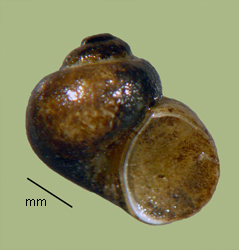Clappia umbilicata
> Habitat & Distribution
Walker described Somatogyrus umbilicata from the Coosa River at Wetumpka, Alabama, where it was for many years considered endemic. Understood now as a subspecies of Somatogyrus currierianus, populations have been identified in rivers draining to the Tennessee as it enters and passes through North Alabama, including the Sequatchie R, South Chicamauga Ck, the Flint R and Piney Ck west of Huntsville. Most tellingly, a population of the umbilicata subspecies seems to intergrade with typical Somatogyrus currierianus currierianus in the Clinch/Powell system of East Tennessee.
We first discovered small populations of lightly-shelled, umbilicate lithoglyphines in the upper Powell and Sequatchie Rivers of Tennessee in 2008-10, but our samples remained unidentified until late 2012, when we adopted the name "Clappia umbilicata." In both rivers, the preferred habitat seems to be calmer backwaters and marginal pools, where individual snails are most commonly observed on sticks and other organic debris. FWGNA Incidence rank for both subspecies combined I-3.
> Ecology & Life History
Hydrobioid snails seem to be rather nonspecific grazers of small particles (Dillon 2000: 94-97). They are typically dioecious, the males being characterized by a penis that arises from the neck. Eggs are generally laid singly, attached in a spare capsule to a solid substrate.
> Taxonomy & Systematics
Somatogyrus was proposed by Gill (1863) to divide out a subset of Amnicola "with the body whorl globose, and the aperture obliquely semicircular," offering Somatogyrus depressus (Tryon 1862) from the banks of the Mississippi River as the type of the genus. The lithoglyphine penial morphology, characterized by a simple, unlobed penis with just the single duct, was described subsequently. Burch followed Thiele in dividing Somatogyrus into two subgenera (Walkerilla and Somatogyrus s.s.) but later opinions suggest little basis for the distinction (Thompson 1984).
Previous versions of this website followed Kabat & Hershler (1993) in recognizing the lithoglyphines as a subfamily in the large, inclusive Hydrobiidae (sl). More recent molecular phylogenetic evidence has suggested raising this group to the full family level, Lithoglyphidae (Wilke et al., 2013). See my essay of 18Aug16 from the link below.
Isaac Lea's (1863) "Amnicola currieriana" is the oldest Tennessee/Cumberland nomen for any hydrobioid population subsequently assigned to Somatogyrus. See the pair of essays I published in 2023 from the links below for the rationale underlying our suggestion that all Tennessee nomina of Somatogyrus be united under it. We also suggested at that time that more lightly-shelled populations, previously allocated to the genus Clappia, are best understood as a subspecies Somatogyrus currierianus umbilicata.
Somatogyrus umbilicata was originally distinguished by Bryant Walker (1904) on the basis of its open umbilicus. In 1909 he described his new genus Clappia and redescribed his S. umbilicata to go into it as "Clappia clappi." So although Walker's genus name was valid, the specific nomen "clappi" was born a junior synonym of umbilicata.
> Maps and Supplementary Resources
> Essays
- The rediscovery of a Clappia population in the Cahaba River of Alabama was featured in my post to the FWNGA blog of 9May05, "Ivory-billed Freshwater Gastropods."
- I reviewed the taxonomic history of the genus Clappia in my post of 9Nov12, "Bryant Walker's Sense of Fairness."
- Additional details regarding our discovery of this obscure subspecies in the Powell and Sequatchie drainages are available in my blog post of 3Dec12, "On Getting Clappia in Tennessee." See also the helpful figure comparing Clappia to Amnicola, Somatogyrus, and juvenile Leptoxis.
- See my essay of 11July23, Somatogyrus and Yankees in North Alabama, for a review of the complicated taxonomic history of lithoglyphine hydrobioid populations in drainages of the Tennessee/Cumberland. That essay features figures of anatomy and shell morphological variation in the genus Somatogyrus.
- In my essay of 15Aug23, The Union in Tennessee, for lithoglyphid hydrobioids, that is, I present evidence that all the Somatogyrus populations of the Tennessee/Cumberland be united under Isaac Lea's nomen, Somatogyrus currierianus, and that populations previously identified as Clappia umbilicata be lowered to subspecific status underneath it.
- Earlier versions of this website, online until August of 2016, adopted the large, broadly-inclusive concept of the Hydrobiidae (sl) following Kabat & Hershler (1993). More recently the FWGNA project has shifted to the Wilke et al. (2013) classification system, distinguishing a much smaller Hydrobiidae (ss) and elevating many hydrobioid taxa previously ranked as subfamilies to the full family level. For more details, see The Classification of the Hydrobioids.
> References
Burch, J. B. (1989)
North American Freshwater Snails. Malacological Publications,
Hamburg, MI. 365 pp.
Dillon, R.T., Jr. (2000)
The Ecology of Freshwater Molluscs. Cambridge University Press,
Cambridge, United Kingdom.
Gill, T. (1863) Systematic
arrangement of the mollusks of the family Viviparidae, and others,
inhabiting the United States. Proceedings of the Academy of
Natural
Sciences of Philadelphia 15: 33 - 40.
Kabat, A.R., and R.
Hershler (1993)
The prosobranch snail family Hydrobiidae (Gastropoda: Rissooidea):
review of classification and supraspecific taxa. Smithsonian
Contributions to Zoology 547:1-94.
Lea, I (1863) Descriptions
of fourteen new species of Melanidae and one Paludina.
Proceedings of the Academy of Natural Sciences of Philadelphia 4: 154
156.
Lea, I (1866) New
Unionidae, Melanidae, etc., chiefly of the United States.
Journal
of the Academy of Natural Sciences of Philadelphia Series 2, 6: 113
187.
Thompson, F. (1984)
North American freshwater snail genera of the hydrobiid subfamily
Lithoglyphinae. Malacologia 25: 109-141.
Walker, B.
(1904) New species of Somatogyrus.
Nautilus 17: 133-142.
Walker, B.
(1909) New Amnicolidae from Alabama.
Nautilus 22: 85 - 90.
Wilke T., Haase M., Hershler R.,
Liu H-P., Misof
B., Ponder W. (2013)
Pushing short DNA
fragments to the limit: Phylogenetic relationships of hydrobioid
gastropods
(Caenogastropoda: Rissooidea). Molecular
Phylogenetics and Evolution 66: 715 736.








